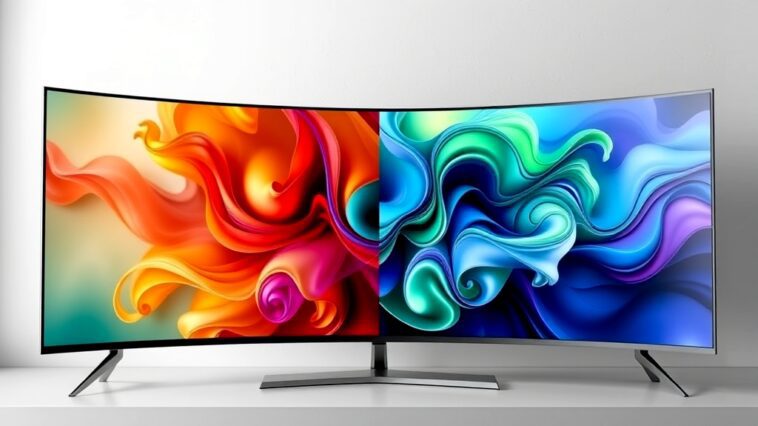So, you’re in the market for a new TV, and you’ve come across the age-old question: Curved vs Flat TV – which should you choose? It’s a debate that has sparked endless discussions among tech enthusiasts and casual viewers alike. Well, let’s break it down, shall we?
The Basics – Curved vs Flat
First off, let’s talk about the two contenders. Curved TVs are designed to wrap around your field of vision, creating a more immersive viewing experience. Flat TVs, on the other hand, are just that – flat. They sit neatly against your wall or on a stand, providing a sleek and modern look to your living room.
But hey, it’s not that simple. Each has its own advantages and disadvantages.
Curved TV Advantages and Disadvantages Compared to Flat Screen
When we dive into curved TV advantages and disadvantages compared to flat screen, it’s essential to consider several factors. Curved TVs are touted for their immersive experience. The curvature can make images appear larger and more enveloping, especially when you’re sitting directly in front of the screen.
However, there’s a downside – viewing angles can be affected. If you’re not sitting directly in front, you might experience some color distortion or reduced brightness. Conversely, flat screens provide consistent picture quality from various angles, making them ideal for larger gatherings when everyone’s not sitting squarely in front.
Best Viewing Distance for Curved vs Flat Televisions
Now, what about the best viewing distance for curved vs flat televisions? Here’s where personal preference really comes into play. General consensus suggests that you should sit about 1.5 to 2.5 times the screen size away from a curved TV for optimal immersion. For flat screens, that distance typically ranges from about 1 to 2 times the screen size. So, if you’re planning on a larger TV, you might want to measure your space accordingly.
Curved TV vs Flat TV for Gaming Experiences
Let’s not forget about gaming! Curved TV vs flat TV for gaming experiences is a hot topic. Curved TVs can enhance your gaming sessions by pulling you into the action, making you feel like you’re part of the game. But, if you’re a competitive gamer or someone who plays with friends often, flat screens might be the way to go. Why? They offer better viewing angles and minimize any potential lag from the curvature, keeping your focus on the game.
Which TV Type is Better for Home Theater: Curved or Flat?
When it comes to the home theater setup, the choice between curved and flat TVs can get complicated. For a dedicated home theater, a curved screen could enhance the cinematic experience, especially for immersive films. But if you’re often entertaining guests, a flat screen may be more practical since everyone can enjoy the movie without worrying about the viewing angles.
Curved vs Flat TV for Large Living Rooms: Pros and Cons
Now, if you have a large living room, the pros and cons of curved vs flat TV come into sharper focus. Curved TVs tend to be better suited for smaller spaces, where the curvature can envelop viewers in a cozy viewing experience. In contrast, flat screens excel in larger rooms by providing a consistent viewing experience across wide angles.
Understanding the Immersive Experience of Curved TVs
Let’s talk immersion. When you watch a movie on a curved TV, it’s kinda like being in a theater. The screen wraps around you, making you feel like you’re part of the world on-screen. Understanding the immersive experience of curved TVs is vital if you’re a cinema buff. But if you’re just watching sitcoms or reality TV, you might not notice much difference.
Flat Screen TV Features That Outperform Curved Models
Now, don’t get me wrong, flat screens have their own set of features that outperform curved models. For one, they tend to be lighter and easier to mount. Plus, they often have more advanced picture technologies—like OLED or QLED—that can provide a better visual experience, especially in brightly lit rooms.
Price Comparison: Curved TVs vs Flat TVs in 2023
Alright, let’s get down to brass tacks: price comparison: curved TVs vs flat TVs in 2023. Generally, curved TVs can be pricier due to their design and technology. However, as tech evolves, flat screens have gotten incredibly affordable. So, if you’re on a budget, you might find a flat screen that fits your needs without breaking the bank.
Curved vs Flat TV: Which is Better for Sports Watching?
If you’re a sports fan, you might be wondering: which is better for sports watching? Flat screens tend to win here, too. Why? Because, during those intense moments, you don’t want your friends to miss that winning goal just because they’re sitting at an angle. Flat screens offer a more consistent experience for everyone in the room.
Design Considerations for Choosing Between Curved and Flat TVs
The design of your TV is a biggie. Design considerations for choosing between curved and flat TVs include aesthetics, room size, and even your personal style. Curved TVs can look pretty sleek and modern, while flat screens offer a more traditional look.
Curved TVs vs Flat TVs: Impact on Viewing Angles and Reflections
Then there’s the issue of viewing angles and reflections. Curved TVs can suffer from reflections, especially if there’s a window behind you. Flat screens, however, are less susceptible to this problem, allowing for a clearer picture regardless of where you’re seated.
Which is More Stylish: Curved TVs or Flat Screen TVs?
Speaking of style, which is more stylish: curved TVs or flat screen TVs? It really depends on your home decor. Curved TVs have a futuristic vibe, whereas flat screens can fit into any traditional or contemporary setting.
Curved vs Flat TV: Customer Reviews and Recommendations
You might be asking yourself, “What are people saying?” Well, curved vs flat TV: customer reviews and recommendations show a split opinion. Some love the immersive experience of curved screens, while others appreciate the versatility and reliability of flat screens. It’s all about what works for you.
Energy Efficiency of Curved TVs Compared to Flat Screens
Now let’s consider energy efficiency. Energy efficiency of curved TVs compared to flat screens is worth noting. Generally, flat screens tend to be more energy-efficient, making them a better choice for eco-conscious consumers.
Future Technology Trends for Curved and Flat Television Displays
Looking ahead, future technology trends for curved and flat television displays are exciting. As we move into 2025, expect to see advancements in both technologies. Curved screens might become more mainstream, while flat screens continue to evolve with better features and picture quality.
Conclusion: The Final Verdict
So, which is it? Curved vs Flat TV – which should you choose? At the end of the day, it really boils down to your viewing habits, room size, and personal preference. If you’re looking for an immersive experience and have the right setup, a curved TV could be your best bet. But if you want something versatile, practical, and great for a variety of viewing angles—go with a flat screen.
And remember, whatever you choose, make sure it fits your lifestyle. Because, honestly, nothing is worse than realizing your new TV just doesn’t vibe with your space. Happy watching!
Other Related Articles
- Eizo Foris FS2331 Review
- How Much Power Does a 144Hz Monitor Use? A Deep Dive into Energy Consumption
- Should I Turn On HDR for Gaming? A Comprehensive Guide
- Is iPhone 16 Pro OLED the Best Display Yet?
- Understanding Panel Variance: What It Means for Your Monitor Purchase
- Can You Throw Computer Monitors in the Trash? The Ultimate Guide to Eco-Friendly Disposal
- Understanding VESA ClearMR: The Future of Motion Clarity in Displays
- 4K vs 1080p – Is UHD Worth The Upgrade?
- How To Choose The Right Gaming Monitor: A Comprehensive Guide
- IPS vs OLED Monitors for Color Accuracy: The Ultimate Showdown
- HDMI 2.1: The Future of Home Entertainment and Gaming
- How to Connect Heart Rate Monitor to PC?
- Curved vs Flat TV – Which Should You Choose? The Ultimate Showdown for 2025
- Can You Connect M-Audio Monitors to PC?
- Why Is My PC Showing the Same Display on Two Monitors?
- Why Are Computer Monitors More Expensive Than TVs?
- The Best Flicker-Free Monitors for Eye Care
- Monitors for Mac vs Windows PCs: The Ultimate Showdown
- 1920×1080 vs 2560×1440 – Which One Should I Choose?
- 99219444 Toshiba and Its Revolutionary Features for Tomorrow’s Tech Landscape
- OLED vs QD-OLED: The Showdown of Display Technologies
- What Is DisplayPort 2.1?
- What Is The Best Monitor Size For Gaming?
- 720p vs 1080p vs 1440p vs 4K vs 8K – Which Should I Choose?
- Is An HDR Gaming Monitor Worth It?
- Mini-LED vs MicroLED: What’s the Difference?
- Do Pawn Shops Take Computer Monitors?
- What LG Computer Monitor is as Good as the C3?
- Understanding Pixel Walk and Pixel Inversion
- Curved vs Flat Monitors for Work: Which One is Right for You?
- What Is The Soap Opera Effect?
- 4K vs 1440p Monitors for Video Editing: Which One Should You Choose?
- Do I Have to Attach a Hood to My BenQ Monitor?
- Can You Use Mac as a Monitor for PC?
- What Is G-SYNC And What Does It Do?
- Daz Studios Summoner G8 for the Visionary Artist
- Dell vs HP Monitors for Gaming
- Understanding IPS Technology: A Comprehensive Guide
- 27-Inch Monitors vs 32-Inch Monitors for Productivity
- Understanding Screen Resolution: Why It Matters for Your Displays
- How to Transport Computer Monitors?
- How to Dispose of Computer Monitors?
- What Is 4K Resolution And Is It Worth It?
- How to Pack Computer Monitor for Moving?
- What Is HDR For TVs And Is It Worth It?
- 1440p or 144Hz – Which Is Best For You?
- USB Type-C Explained – Everything You Need To Know
- Samsung’s Exciting Journey into Glasses-Free 3D Displays at Gamescom 2024
- I Have A Problem with My Samsung Odyssey G3 Monitor Setup
- Is A 144Hz Monitor Worth It? A Comprehensive Guide
- Understanding FALD Blooming and the Halo Effect: A Deep Dive
- What Does 144Hz Mean? Understanding Refresh Rates in Simple Terms
- Is an UltraWide Monitor the Right Choice for You?
- Active vs Passive 3D – What’s The Difference?
- Understanding Glare Control in Luminaires for Computer Users
- Why Does My Acer Monitor Keep Going Black?
- Understanding Motion Blur Reduction: A Gamer’s Guide
- How to Connect Studio Monitors to PC?
- Misleading Monitor Specifications You Should Look Out For
- QLED vs OLED – Which Is Best?
- Understanding VESA AdaptiveSync and MediaSync: The Future of Display Technology




